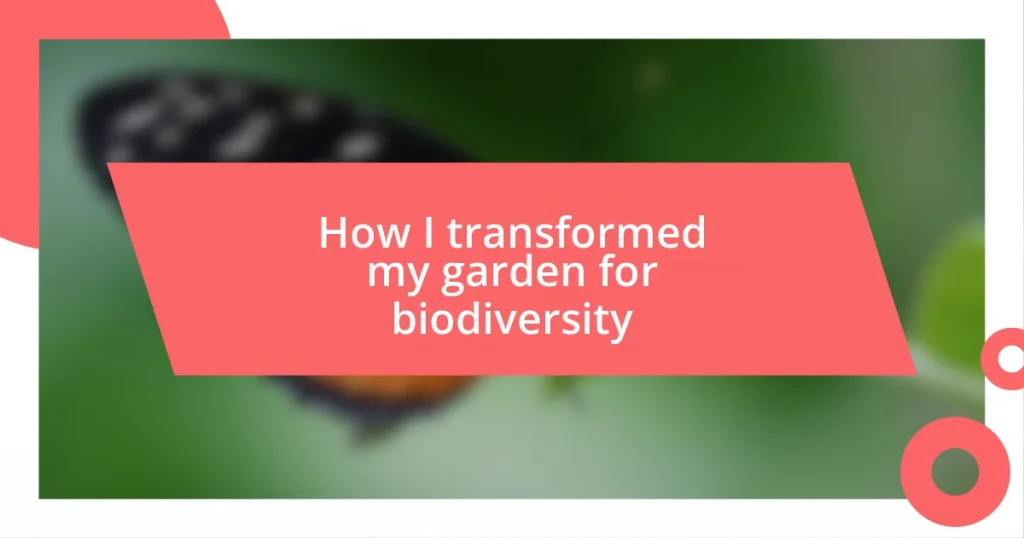Key takeaways:
- Transforming the garden by incorporating diverse native plants attracted various pollinators and improved the ecosystem’s resilience against pests.
- Implementing sustainable practices, such as organic gardening and water conservation, enhanced plant health and created a wildlife-friendly habitat.
- Sharing the journey and engaging with the community fostered a collective awareness and initiative toward biodiversity, inspiring others to cultivate wildlife-friendly gardens.
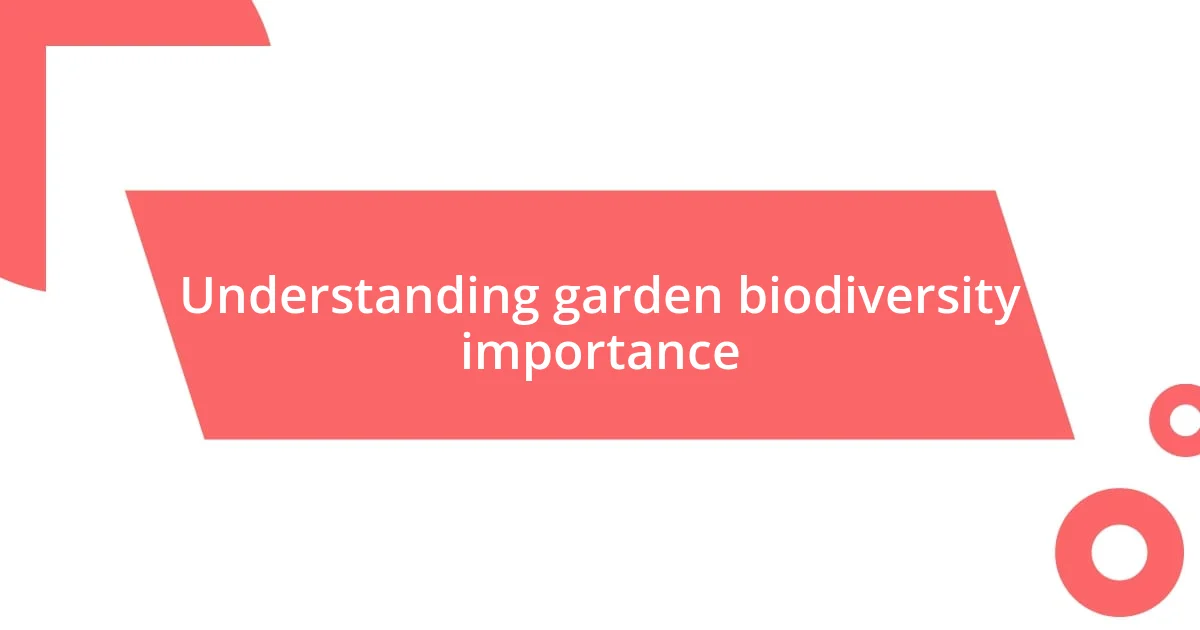
Understanding garden biodiversity importance
Understanding the importance of garden biodiversity is like unlocking a treasure chest of life. When I first started my garden transformation, I realized that a garden abundant in diverse plants attracts a variety of pollinators, such as bees and butterflies. Isn’t it amazing to think that these little creatures are essential for the pollination of many of our food crops and wild plants?
As I cultivated different species, I noticed a delightful shift in my garden ecosystem. Each time I encountered a new insect or bird species, it felt like an affirmation that I was contributing positively to the environment. This makes me wonder: how can our gardens serve as vital habitats in an increasingly urbanized world?
Furthermore, biodiversity acts as a safeguard against pests and diseases. For example, when one plant struggles, the others can still thrive, creating a more resilient garden. I remember the year when my tomato plants were afflicted by blight, but thanks to my diverse planting strategy, my peppers and herbs flourished, ensuring I still had a good harvest. Isn’t it reassuring to think that a varied garden can withstand the unforeseen challenges nature throws our way?
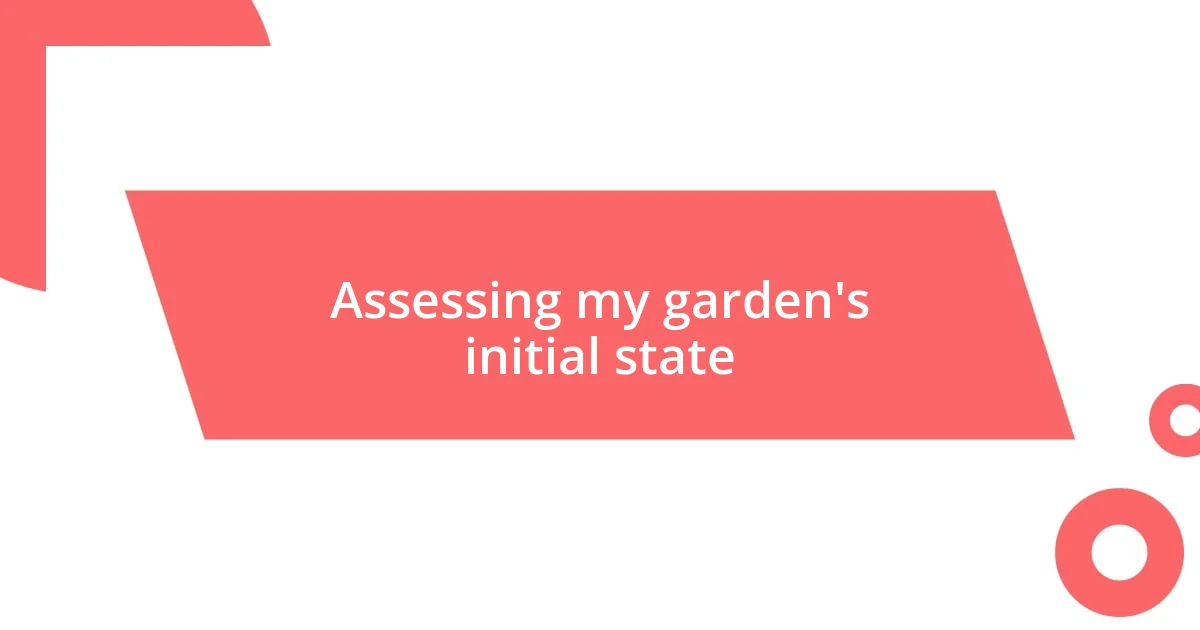
Assessing my garden’s initial state
Before diving into my garden transformation, I took a moment to assess its initial state. To be honest, I was a bit disheartened. My garden was primarily a patch of grass with a few scattered flowerbeds, devoid of the vibrant life I envisioned. This lack of diversity not only limited the number of visitors—like cheerful butterflies and buzzing bees—but it also made my garden susceptible to pests. Looking back, I realize how critical that assessment was; it set the foundation for everything that followed.
In evaluating the spaces within my garden, I noticed a stark contrast between the areas rich in variety and those that were not. In the flowerbeds, a handful of perennial plants struggled to keep the space lively, while the patches of grass became overrun with weeds. It struck me that I needed to create a welcoming environment, one that would intrigue the local fauna and inspire plant growth. Reflecting on my journey, I can’t help but think about how every corner of that initial garden held untapped potential waiting to be nurtured.
My initial assessment also made me recognize the importance of soil quality and design. It was heartbreaking to dig down and find compacted earth that struggled to retain moisture. I remember the excitement I felt when I started to envision a landscape alive with colors, textures, and sounds. Visualizing those changes propelled me forward into this transformative journey, guiding my choices on plants and layouts that would bring about not just biodiversity, but a deeper connection to nature.
| Aspect | Initial State |
|---|---|
| Plant Diversity | Low, mainly grass and a few flowerbeds |
| Pollinator Presence | Minimal, few butterflies and bees |
| Pest Resistance | Vulnerable, not many natural barriers |
| Soil Quality | Compacted, poor moisture retention |
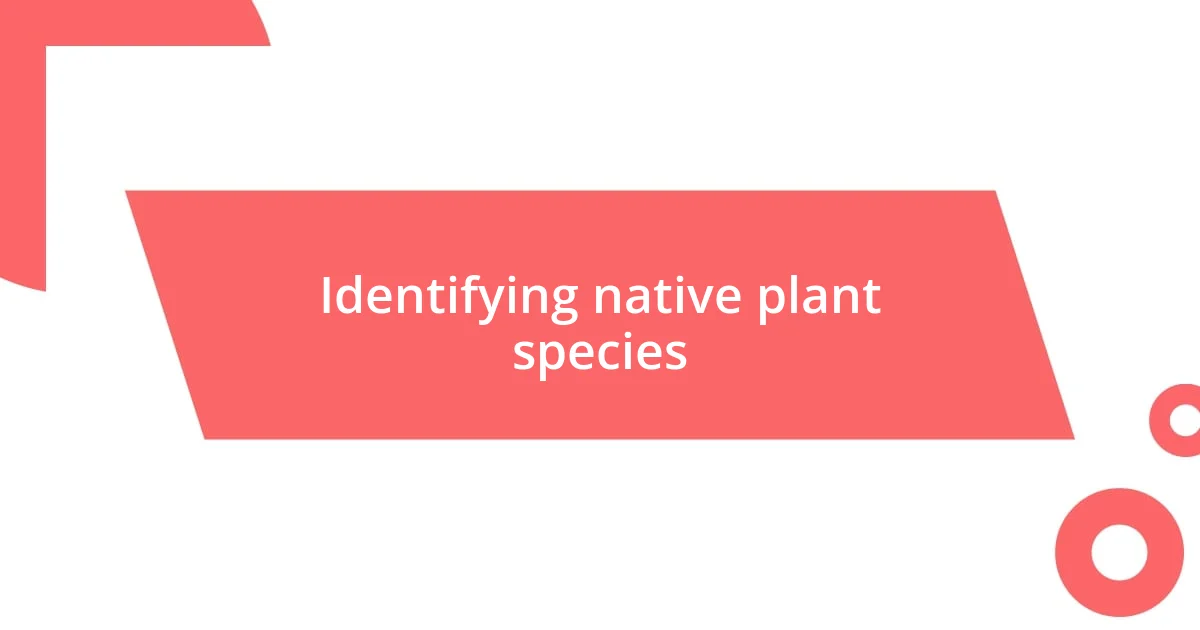
Identifying native plant species
Identifying native plant species was a revelation for me. I had always assumed that any plant could thrive in my garden, but learning about native species transformed my perspective. These plants are not just beautiful; they are perfectly adapted to the local climate and soil conditions. I felt a sense of responsibility as I discovered how choosing native plants could support the local ecosystem. For instance, I remember spotting a patch of wildflowers that brought a flurry of butterflies to my yard. Watching their delicate dances opened my eyes to the intricate web of life around us.
To make the process easier, I created a quick reference list of native plants suitable for my garden:
- Purple Coneflower (Echinacea purpurea): Attracts butterflies and is drought-resistant.
- Black-eyed Susan (Rudbeckia hirta): Bright yellow blooms that draw in pollinators.
- Butterfly Weed (Asclepias tuberosa): Essential for monarchs, it adds vibrant color.
- Blazing Star (Liatris spicata): A striking spike that invites various pollinators.
- Serviceberry (Amelanchier alnifolia): Offers fruit for birds and beautiful spring flowers.
Each time I added one of these plants to my garden, I felt a rush of excitement. It was like welcoming a new friend who would play a vital role in my garden’s ecosystem. I found joy in watching the bursts of color and the bustling activity of pollinators that became a regular part of my daily life. It’s funny how something as simple as choosing native plants can reignite our connection to the natural world.
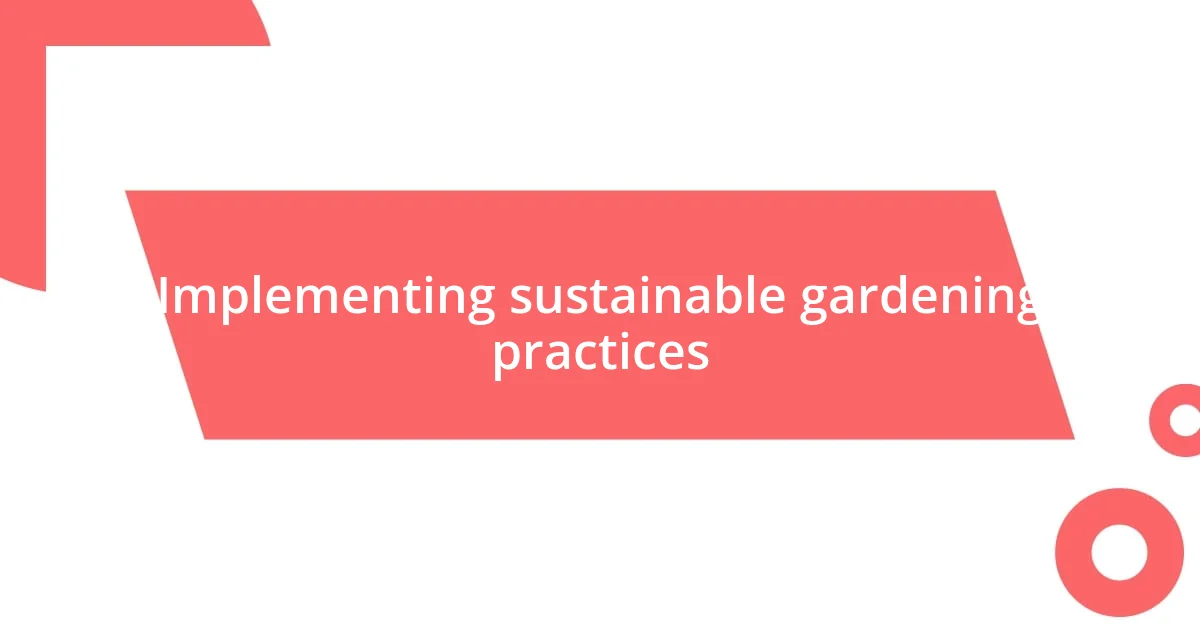
Implementing sustainable gardening practices
Implementing sustainable gardening practices became a delightful journey for me, blending responsibility with creativity. I started learning about organic gardening techniques; replacing chemical fertilizers with compost was a game changer. I still remember the first time I applied my homemade compost to the soil—it felt like giving my plants a delicious meal. The earth seemed to breathe a little easier, and the difference was evident. Have you ever watched your plants thrive after nourishing them with natural ingredients? It’s a rewarding experience like no other.
As I explored sustainable practices, I realized the value of water conservation. I installed a rain barrel to collect water, and the first time I used rainwater to hydrate my plants, it felt surprisingly fulfilling. I couldn’t help but notice how much happier my garden seemed, flourishing with less waste. Small steps, like mulching to retain moisture and planting drought-resistant species, significantly lowered my water consumption. Every drop saved not only conserved resources but also brought me closer to a thriving ecosystem. Isn’t it amazing how our gardens can reflect our choices?
Additionally, I embraced the idea of creating a wildlife-friendly habitat, welcoming creatures into my space. I set up bee hotels and bird feeders, transforming my garden into a bustling sanctuary. Observing the birds flutter to the feeders filled me with joy; I felt like I was supporting the community in my own backyard. It sparked a curiosity in me. How many lives can a simple garden impact? By implementing these practices, I realized that sustainability isn’t just about preserving resources—it’s about nurturing a symbiotic relationship with nature.
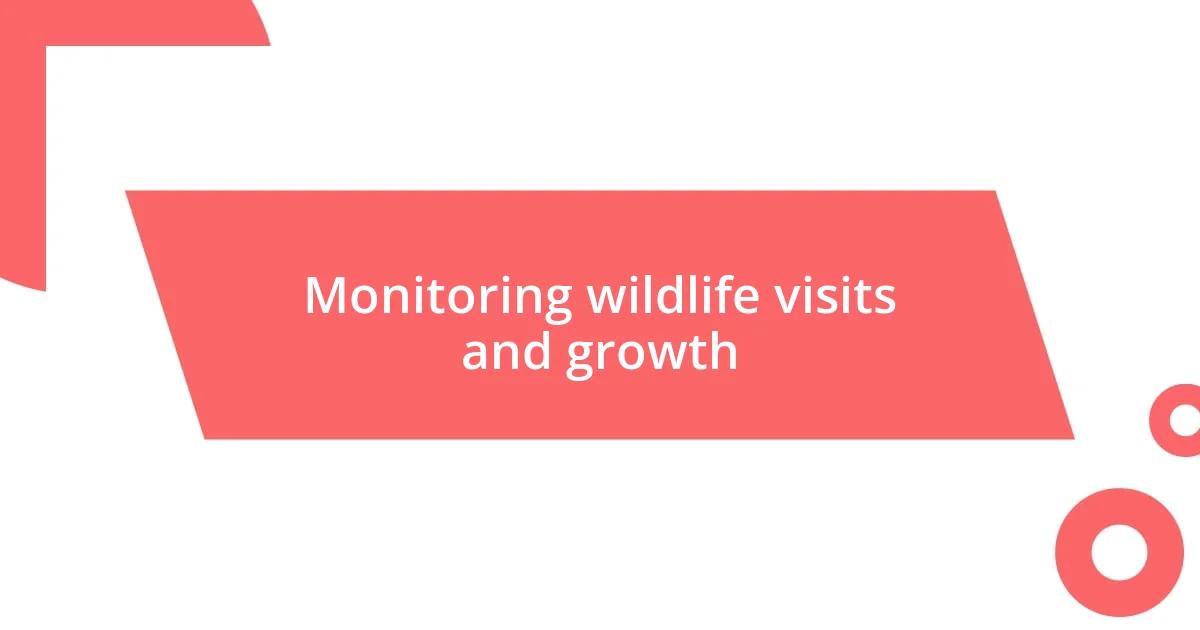
Monitoring wildlife visits and growth
Monitoring wildlife visits has become one of my favorite pastimes. I set up a simple notebook dedicated to tracking who visits my garden. Each rustle in the bushes or chirp overhead brings a wave of anticipation. Did you know that keeping a log of these visits can provide insight into what species are thriving in your space? The first time I spotted a family of rabbits nibbling on my clover patch, I felt an immense thrill—my garden was truly coming alive!
Growth is another exciting aspect of my garden’s transformation. I frequently take photos of new blooms and shoots, creating a visual diary of my garden’s evolution. I vividly remember the moment my first butterfly bush began to flourish. Not only did it add a pop of color, but it also attracted an incredible array of pollinators. Reflecting on these changes has deepened my appreciation for the gardening process. Have you ever noticed how watching your plants grow feels like witnessing a miracle?
Lastly, I find it crucial to engage the community in my observations. Sharing my wildlife visits with friends often leads to enlightening discussions about our local ecosystems. I once invited a neighbor to join me for a garden tea, and we spent hours sharing stories about the different birds and insects we’d each seen. This connection not only enriched my understanding but also sparked a renewed passion in others about the benefits of biodiversity. Engaging with the wildlife in my garden, and even involving others in my experiences, feels like being part of something much larger than myself. Don’t you just love those moments of shared discovery?
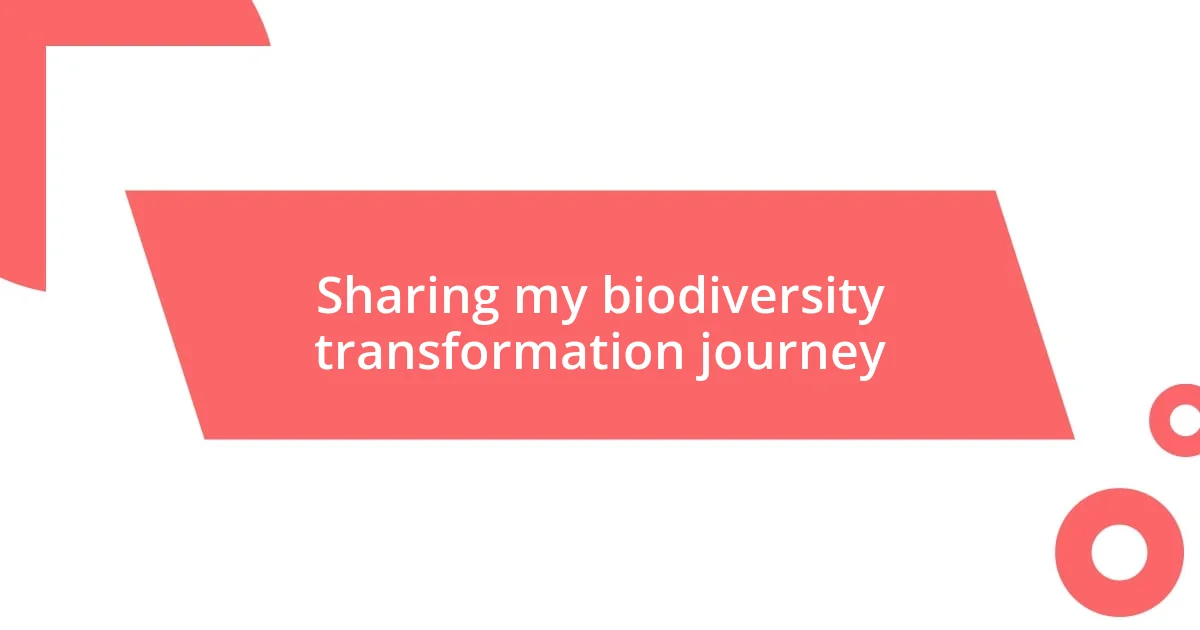
Sharing my biodiversity transformation journey
Sharing my biodiversity transformation journey has been both enlightening and invigorating. One of the most memorable transitions happened when I added native plants to my garden. I can still recall the moment I planted my first local wildflower. It felt like welcoming an old friend back home, as if the natural ecosystem was finally finding its way back to my yard. Isn’t it fascinating how native plants not only thrive better but also invite a plethora of pollinators? Every bloom seems to tell a story, and watching the bees dance among the petals reminds me of our essential connection to nature.
As the seasons changed, so too did the variety of wildlife in my garden. I remember the first time I spotted a painted lady butterfly fluttering around. The sheer joy it brought me was unexpected, leaving me with a warm sense of accomplishment. Have you ever experienced that moment when you realize your efforts are truly making a difference? Observing these creatures flourish in the habitat I’ve cultivated fills me with hope. My garden is no longer just an array of plants; it’s a lively tapestry of interconnected lives.
Another significant part of my journey involved engaging with local wildlife enthusiasts. I began sharing my experiences on social media, and the feedback was astounding. I was surprised at how many neighbors joined me in creating their own wildlife-friendly gardens, each showcasing their unique stories. It’s exhilarating to think that my small changes spurred others to take action. Isn’t it uplifting to consider how sharing our journeys can inspire others? Watching this ripple effect of biodiversity awareness grow around me leaves me genuinely excited about what’s to come.










